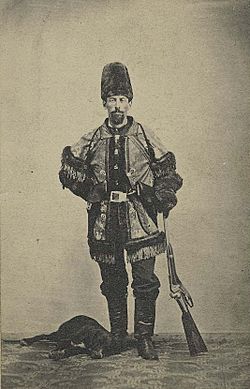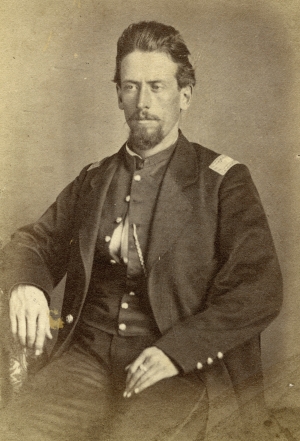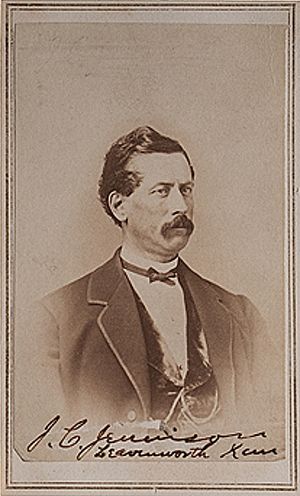Charles R. Jennison facts for kids
Quick facts for kids
Charles Rainsford Jennison
|
|
|---|---|

Charles R. Jennison, ca. 1855-1860
|
|
| Personal details | |
| Born | June 6, 1834 Antwerp, New York |
| Died | June 21, 1884 (aged 50) Leavenworth, Kansas |
| Political party | Republican |
| Nickname | "Doc" |
| Military service | |
| Allegiance | United States of America |
| Years of service | 1861–1864 |
| Rank | |
| Commands | Jennison's Jayhawkers (7th Kansas Volunteer Cavalry) 15th Kansas Volunteer Cavalry |
| Battles/wars | |
Charles Rainsford Jennison (born June 6, 1834 – died June 21, 1884) was an important figure in Kansas history. He was known as "Doc" Jennison. He played a role in the anti-slavery movement during a time called Bleeding Kansas. He was also a famous Jayhawker and later served in the Kansas State Senate. During the American Civil War, he became a Union colonel and led groups of Jayhawker soldiers.
Early Life and the Fight Against Slavery
Charles R. Jennison was born on June 6, 1834, in Antwerp, New York. When he was 12, his family moved to Wisconsin. There, Jennison studied medicine.
In 1858, at age 24, he moved to Osawatomie, Kansas. Soon after, he moved to Mound City, Kansas. Kansas was a new territory where people were fighting over whether slavery should be allowed. This period was known as "Bleeding Kansas" because of the violence.
Jennison became a leader among the jayhawkers. These were groups who strongly opposed slavery. They often clashed with pro-slavery settlers. Jennison worked with other anti-slavery leaders like James Montgomery.
Serving in the Civil War
Even before the Civil War officially began, Jennison became a captain of the Mound City Guards in February 1861. In September, he was made a colonel by Kansas Governor Charles L. Robinson.
On October 28, 1861, Jennison formed his own group of soldiers. This group was called the 7th Kansas Cavalry. They became famous as "Jennison's Jayhawkers." Their job was to patrol the border between Kansas and Missouri. They wanted to stop pro-slavery forces from crossing into Kansas.
Jennison was a strong abolitionist. This means he believed slavery should be ended everywhere. He was known for saying that enslaved people could find safety in his camp. He promised to protect them.
In April 1862, Jennison left the army for a short time. However, after the terrible Lawrence Massacre, he was called back to duty. Kansas Governor Thomas Carney asked him to raise a new regiment. On October 17, 1863, Jennison formed the 15th Kansas Cavalry.
In October 1864, Colonel Jennison led a group of Kansas soldiers. They fought against a large attack by Confederate forces known as Price's Raid. After pursuing the enemy through Missouri, Jennison's military service ended in June 1865.
Life After the War
After the Civil War, Charles Jennison continued to be active in politics. He was elected to the Kansas Legislature from Leavenworth County in 1865. He was re-elected in 1867.
In 1872, he was elected to the Kansas State Senate. Charles R. Jennison passed away in Leavenworth, Kansas on June 21, 1884.



